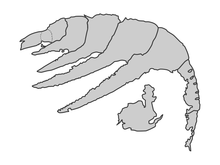Peytoia infercambriensis
| Peytoia infercambriensis Temporal range:
| |
|---|---|

| |
| Interpretive drawing of holotype specimen of P. infercambriensis | |
| Scientific classification | |
| Kingdom: | Animalia |
| Phylum: | Arthropoda |
| Class: | †Dinocaridida |
| Order: | †Radiodonta |
| Family: | †Hurdiidae |
| Genus: | †Peytoia |
| Species: | †P. infercambriensis
|
| Binomial name | |
| †Peytoia infercambriensis (Lendzion, 1975)
| |
Peytoia infercambriensis is a species of hurdiid formerly assigned to the genus Cassubia. It is known from drillcore material that was collected from the Lower Cambrian of Kashubia, Poland at 4.8 kilometres depth.
Etymology[]
The species name is derived from the Latin words for "Lower Cambrian".[1] The former genus name Pomerania refers to the Latinized name for Pomorze, a region of northern Poland. The replacement name for the preoccupied genus, Cassubia, is derived from the Latinization of Kaszuby, the region in Poland where the holotype specimen was discovered.[2]
History[]
The holotype—and only—specimen was recovered from the Kościerzyna borehole, in the Cambrian Stage 3 aged . It was found in the Fallotaspis Zone making it older than the Chengjiang biota. It was described by Kazimiera Lendzion in 1975 and given the name Pomerania infercambriensis,[1] a name which soon proved to be preoccupied by a Middle Jurassic ammonoid.[2] In her initial description, Lendzion interpreted the fossil as preserving 11 thoracic segments and a chelicera of a Leanchoilia-like arthropod.[1] Subsequent study identified it as an anomalocaridid-like frontal appendage. At first, the portion originally identified as thoracic segments was interpreted as representing the base of an elongate appendage, but it appears to be the body of an indeterminate arthropod.[3]
Classification[]
Peytoia infercambriensis may represent a transitional form between taxa with two rows of similar ventral spines such as Anomalocaris pennsylvanica and taxa with highly differentiated ventral spines such as Peytoia nathorsti.[4] It bears particular similarity to Anomalocaris pennsylvanica and Tamisiocaris borealis.[4][5]
Description[]
The frontal appendage was made up of at least 18 segments and had long, straight ventral spines. It is not known whether the ventral spines were paired like in most related taxa. On the anterior edge of the spines were minute serrations which may form the bases of setae.[4]
Paleobiology[]
If the ventral spines possessed setae, Peytoia infercambriensis may have used its frontal appendages to filter through fine sediment.[4]
References[]
- ^ a b c Lendzion, Kazimiera (1975). "Fauna of the Mobergella zone in the Polish Lower Cambrian". 19 (2): 237–242. Cite journal requires
|journal=(help) - ^ a b Lendzion, Kazimiera (1977). "Cassubia - a new generic name for Pomerania Lendzion, 1975". Geological Quarterly. 21 (1).
- ^ Daley, A. C.; Legg, D. A. (2015). "A morphological and taxonomic appraisal of the oldest anomalocaridid from the Lower Cambrian of Poland". Geological Magazine. 152 (5): 949–955. doi:10.1017/S0016756815000412.
- ^ a b c d Dzik, Jerzy; Lendzion, Kazimiera (1988). "The oldest arthropods of the East European Platform". Lethaia. 21: 29–38. doi:10.1111/j.1502-3931.1988.tb01749.x.
- ^ Daley, Allison C.; Peel, John S. (2010). "A possible anomalocaridid from the Cambrian Sirius Passet Lagerstätte, North Greenland". Journal of Paleontology. 84 (2): 352–355. doi:10.1666/09-136R1.1.
- Fossils of Poland
- Anomalocaridids